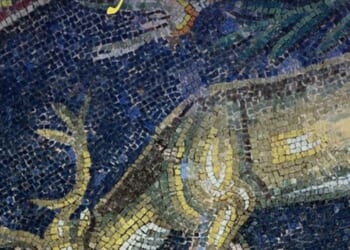Three burial mounds have stunned archaeologists after they were uncovered in southern Bulgaria, revealing the graves of two warriors and a noblewoman from ancient Thrace.
The tombs, which date back to the late Hellenistic area, were unearthed by a research team from the Bulgarian Academy of Science during electrical cable installation work in Kapitan Petko Voyvoda, near the Turkish border.
The first warrior’s cremated remains were discovered alongside those of his warhorse, accompanied by an extraordinary collection of grave goods.
Spears, shields and swords with handles covered in gold and embedded with semi-precious stones were found in the tomb.
A ceremonial dagger decorated with gold and gemstones was also recovered and the horse had been buried with gold, silver and bronze ornamental pieces.
“The quality of the metals and the meticulous engravings suggest we are looking at a goldsmithing workshop linked to Thracian royal courts or even itinerant Hellenistic masters,” archaeologist Daniela Agre told a press conference at the National Archaeological Institute of Bulgaria.

BULGARIAN ACADEMY OF SCIENCES
|
The graces of two warriors and a noblewoman have been uncovered in southern Bulgaria
The second warrior’s grave, measuring approximately nine-foot square and three foot deep, contained the skeleton of a man aged between 35 and 40 years.
He was discovered wearing a silver wreath on his head.
His horse’s bridle featured an image depicting Hercules overcoming the giant Antaeus, whilst the harness bore gilded bronze decorations.
Archaeologist Vladimir Staykov said: “The level of detail is astonishing: the tense muscles, the expression of agony on Antaeus’ face.
LATEST ARCHAEOLOGY BREAKTHROUGHS:

BULGARIAN ACADEMY OF SCIENCES
|
Archaeologists were amazing at the detail on the artifacts found
“This is not local craftmanship; it’s a piece imported from a first-rate workshop, probably in Pergamon or Alexandria.”
The tomb also yielded iron spears, a curved Greek Mahira blade, an iron shield and silver jewellery.
The noblewoman’s burial included two pairs of leather shoes in good condition, a wooden box decorated with gold and silver plating featuring semi-precious stones, plus bronze, glass and amber objects.
A nearby ritual site revealed coins bearing images of various rulers and originating from different minting locations.
Agre suggested this indicates the area served as either a destination for pilgrims or a centre for trade.
The researchers noted that the discovery of multiple high-status burials containing valuable objects at a single location could transform the understanding of political hierarchies in pre-Roman Thrace.
The concentration of wealth and the quality of imported goods found in the tombs suggest the site held greater significance than previously recognised for the region’s power structures.
The artifacts will be exhibited at the National Archaeological Museum in Sofia.
















